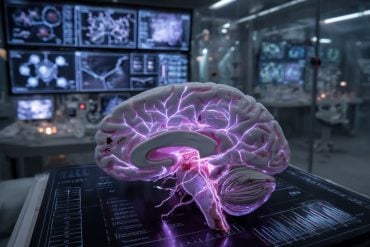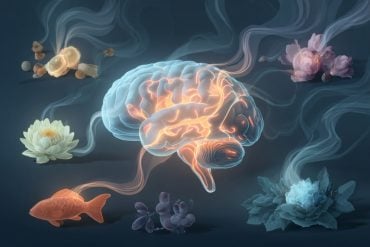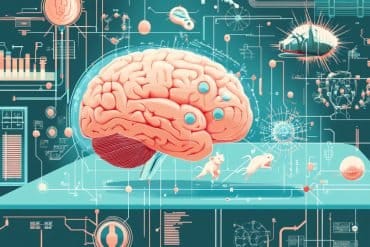Summary: Researchers have identified a new neurodegenerative disease that is caused by a genetic mutation that disrupts DNA repair.
Source: University of Sussex.
New disease could signal hope for sufferers of brain ageing conditions.
A new genetic disease which results in neurodegeneration has been discovered by experts at the University of Sussex.
In a study published today, Wednesday 21 December, in the top scientific journal Nature, the team from the University of Sussex’s Genome Damage and Stability Centre (GDSC) reveal they have discovered the disease, ataxia oculomotor apraxia type XRCC1, which is caused by a genetic mutation that disrupts the repair of our DNA.
The team discovered that when single strands of our DNA are damaged, a genetic mutation in a gene called XRCC1 causes a vital DNA-repairing enzyme (known as PARP1) in our bodies to over-activate. In people suffering from the new disease the scientists discovered the speeding up of this key enzyme actually triggers the death of brain cells.
Single strand breaks are one of the most common types of DNA damage and the researchers believe it’s possible the discovery of this new genetic disease could be important for scientists researching other rare DNA repair related diseases. The team also believe the findings could eventually prove significant for researchers looking into more common neurodegenerative and brain ageing conditions, such as Alzheimer’s, Huntington’s and Parkinson’s.

Professor Keith Caldecott, who led on the study, said: “Discovering this new disease and its cause is a huge step towards developing drug-based therapies for other rare neurodegenerative conditions.
“Drugs which target this key DNA repairing enzyme in the right way, could prove vital for treating people suffering from diseases caused by the over-activation of this protein – it is now crucial we determine what diseases these are.
“More research needs to be done – but it’s also possible the cause of this newly discovered condition could contribute to the death of nerve cells in people suffering from diseases such as, Alzheimer’s, Huntington’s and Parkinson’s.”
Funding: The research was funded by Medical Research Council.
Source: Lynsey Ford – University of Sussex
Image Source: NeuroscienceNews.com image is in the public domain.
Original Research: Abstract for “XRCC1 mutation is associated with PARP1 hyperactivation and cerebellar ataxia” by Nicolas C. Hoch, Hana Hanzlikova, Stuart L. Rulten, Martine Tétreault, Emilia Komulainen, Limei Ju, Peter Hornyak, Zhihong Zeng, William Gittens, Stephanie A. Rey, Kevin Staras, Grazia M. S. Mancini, Peter J. McKinnon, Zhao-Qi Wang, Justin D. Wagner, Care4Rare Canada Consortium, Kym Boycott, Alex MacKenzie, Jacek Majewski, Michael Brudno, Dennis Bulman, David Dyment, Grace Yoon & Keith W. Caldecottn in Nature. Published online December 21 2016 doi:10.1038/nature20790
[cbtabs][cbtab title=”MLA”]University of Sussex “New Genetic Disease That Results in Neurodegeneration Discovered.” NeuroscienceNews. NeuroscienceNews, 21 December 2016.
<https://neurosciencenews.com/genetics-neurodegeneration-xrcc1-5790/>.[/cbtab][cbtab title=”APA”]University of Sussex (2016, December 21). New Genetic Disease That Results in Neurodegeneration Discovered. NeuroscienceNew. Retrieved December 21, 2016 from https://neurosciencenews.com/genetics-neurodegeneration-xrcc1-5790/[/cbtab][cbtab title=”Chicago”]University of Sussex “New Genetic Disease That Results in Neurodegeneration Discovered.” https://neurosciencenews.com/genetics-neurodegeneration-xrcc1-5790/ (accessed December 21, 2016).[/cbtab][/cbtabs]
Abstract
XRCC1 mutation is associated with PARP1 hyperactivation and cerebellar ataxia
XRCC1 is a molecular scaffold protein that assembles multi-protein complexes involved in DNA single-strand break repair. Here we show that biallelic mutations in the human XRCC1 gene are associated with ocular motor apraxia, axonal neuropathy, and progressive cerebellar ataxia. Cells from a patient with mutations in XRCC1 exhibited not only reduced rates of single-strand break repair but also elevated levels of protein ADP-ribosylation. This latter phenotype is recapitulated in a related syndrome caused by mutations in the XRCC1 partner protein PNKP and implicates hyperactivation of poly(ADP-ribose) polymerase/s as a cause of cerebellar ataxia. Indeed, remarkably, genetic deletion of Parp1 rescued normal cerebellar ADP-ribose levels and reduced the loss of cerebellar neurons and ataxia in Xrcc1-defective mice, identifying a molecular mechanism by which endogenous single-strand breaks trigger neuropathology. Collectively, these data establish the importance of XRCC1 protein complexes for normal neurological function and identify PARP1 as a therapeutic target in DNA strand break repair-defective disease.
“XRCC1 mutation is associated with PARP1 hyperactivation and cerebellar ataxia” by Nicolas C. Hoch, Hana Hanzlikova, Stuart L. Rulten, Martine Tétreault, Emilia Komulainen, Limei Ju, Peter Hornyak, Zhihong Zeng, William Gittens, Stephanie A. Rey, Kevin Staras, Grazia M. S. Mancini, Peter J. McKinnon, Zhao-Qi Wang, Justin D. Wagner, Care4Rare Canada Consortium, Kym Boycott, Alex MacKenzie, Jacek Majewski, Michael Brudno, Dennis Bulman, David Dyment, Grace Yoon & Keith W. Caldecottn in Nature. Published online December 21 2016 doi:10.1038/nature20790






